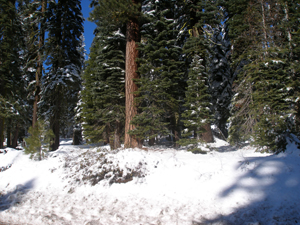 Sierra Nevada Forest
Sierra Nevada Forest
After we moved to California in 1970, we learned, through our children's schooling,
of the California Gold Rush of 1849, which led to almost immediate statehood. Then,
in 1972, we drove north on California Highway 49, aptly numbered, which went through
one old mining boom town after another. We heard stories of gold nuggets as big as
your fist, more saloons and bawdy houses than groceries, the exotic Chinese, and
frenzied panning and filing of mining claims as prospectors swarmed over the Sierra
foothills. The names of the rivers which washed down from the mountains still have
a magical ring: Yuba, Feather, American, Tuolumne.
 Sierra Nevada Forest
Sierra Nevada Forest
Occasionally the panning traces led the prospectors to hard rock mines, where rich
lodes of gold-bearing quartz were hauled to the surface and crushed in stamp mills.
But the placer miners were the most frenzied, and soon turned the rushing river waters
against themselves, rigging high-pressure "hydraulicking" nozzles to dig up the stream
beds in search of more and more of the shiny color, and leaving ravaged heaps of ugly
rock along the stream beds. Fights were an everyday occurrence, the foundation of
modern mining law was laid, and the term lynching was named after a Mr. Lynch, although
it originally meant just a whipping.
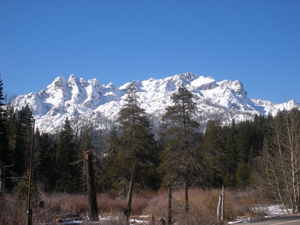 Sierra Buttes
Sierra Buttes
This year we turned back our memories to 1972 as we drove the length of highway 49 from the cold winter snows of the Northern Sierra all the way to its southern terminus near Fresno, ending in a riot of springtime flowers and temperatures in the 70s. We took our time, spending three nights along the way.
One thing that's changed is that the country is built up. Wherever the Sierra foothills are a tolerable drive from the working cities of Sacramento or Stockton or even the San Francisco Bay, developers have come in with their bulldozers and built housing developments with beautiful landscaping nestled in the rolling hills.
Another is that the quaint old mining towns with their dilapidated 19th century storefronts
have been yuppified, and now are filled with wine bars, espresso cafes, ye olde antique
shoppes, and stores with equipment for a bewildering variety of outdoor sports, some of
which didn't exist in the 1970s, let alone the 1850s. Some of the old hotels have been
remodeled with Victorian furnishings and are now upscale B&Bs.
 Hydraulic mining equipment
Hydraulic mining equipment
We managed to beat the crowds heading to Yosemite on President's Day weekend, and generally enjoyed light traffic, although our penalty was that all the museums were closed for the season. Still we had some good travel guides from the AAA.
The northern end of Route 49 is just outside Loyalton, in a broad valley filled with hayfields and pastures. Soon we climbed a fairly steep rise and began to see striking scenery: layers of hills covered with evergreens and manzanita, small pastures, rushing rivers and waterfalls, granite mountain faces, and very few visible homes. Large boulders abound; in fact, we drove past several recent rock slides and watched one good-sized boulder slide down a hillside towards our truck, only to be caught at the last minute by the protective fence. Thank you, CALTRANS!
Most of the Gold Rush towns have the same history: first nothing at all, then a prospector
finds color in the stream, then hundreds of prospectors appear from nowhere. Tents spring
up. Prices are sky high, because the trails are so muddy it's hard for the merchants to
bring in wagons. Then, if the gold holds out, the town mushrooms to about 5,000 souls,
at which time it is the largest town in the (county, state, west of the Rockies, etc.)
and a candidate for the seat of government. Perhaps the gold is so rich that a hard
rock mine is built, to last well into the 20th century. But more likely it's just placer
gold, washed down from some unknown Eldorado deep in the Sierras, and then the town is
soon deserted by the placer miners, and sooner or later a terrible fire leaves only the
stone buildings surviving for the 21st century tourists.
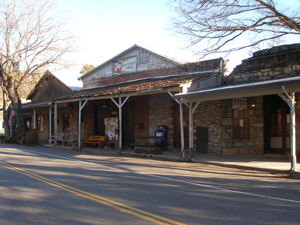 Volcano, California
Volcano, California
The California Gold Rush ended as quickly as it started. When word came of silver in Nevada's Comstock Lode, or (better yet) more gold in the Yukon, California's miners rushed off in search of their next chance to become millionaires. Most died poor, but a few did become rich and famous. It was the merchants and bankers and railroad men who built the biggest fortunes. But they had moved to San Francisco, and there were many ghost towns in the Sierras.
Historical markers are everywhere. The Native Sons of the Golden West, the Masons,
and The State of California, have all contributed markers. Sometimes one tumble-down
building will have markers from three or four organizations. It's a good place to be
in the business of casting bronze plaques.
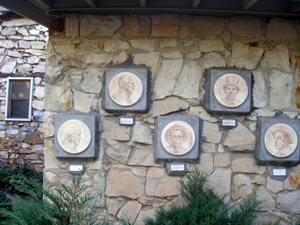 Some Comparative Ovations
Some Comparative Ovations
On our 1972 trips we discovered with glee the plaques placed by a then-mysterious organization known as E Clampus Vitus, with a witty historical message and often terminated by the phrase "Credo Quia Absurdum." ECV is a light-hearted fraternity originating in the East, which took hold with a vengeance in the hard-drinking gold-rush towns, especially among the merchants and writers. As their fortune prospered, many of the members became community leaders in California, but they still gather for chapter meetings and to elect their Grand Humbug leaders.
In Murphys, we found once again the most visited of the Clamper displays: The Wall of Comparative Ovations -- plaster plaques mounted on the outside wall of a gold rush-era building. For the most part, they honor specific members, but they also include appreciations of many of the different groups of miners and laborers who passed through the mountains. Murphys also qualifies as one of the Yuppie towns, as these lines from a restaurant menu testify (no kidding):
"Red Aka Tofu Cylinder: Condensed mango aioli, mint chutney, crushed samble cashews;
"Smoked Red City Glazed Brussel Sprouts: coriander dusted lotus root, lychee froth, olive dust."
In several towns, we noticed prayer cloths strung from one building to another, indicating many current day Buddhist residents hoping for peace.
We took a side road from Colfax, crossing the North and Middle Forks of the American River.
Since the main roads were two lanes wide, we were not surprised to find a sign warning us
that we were about to take a primitive road. But we hadn't anticipated that the
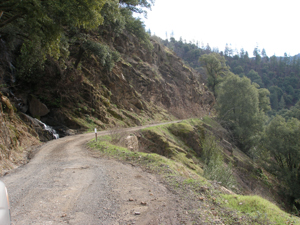 Primitive road
one-and-a-quarter-lane road of wet dirt with occasional sharp rocks would snake down a
canyon, with no guard rails or shoulders. Mercifully, there was almost no traffic.
After slowly negotiating this path we came to the American River suspension bridge. It
reminded us of a footbridge, which swings and sways with each step. Slowly we drove our
fully laden truck onto the span, literally suspended and swinging over the river bed.
We inched across. Going up the other side was where the primitive road was narrowest
and the cliffside the steepest. We knew the only way out was forward, as proceeding in
reverse would have been the sheerest of folly! But eventually the road widened, and then
some wealthy or influential forest dweller had seen that the road was paved all the way
to his or her driveway.
Primitive road
one-and-a-quarter-lane road of wet dirt with occasional sharp rocks would snake down a
canyon, with no guard rails or shoulders. Mercifully, there was almost no traffic.
After slowly negotiating this path we came to the American River suspension bridge. It
reminded us of a footbridge, which swings and sways with each step. Slowly we drove our
fully laden truck onto the span, literally suspended and swinging over the river bed.
We inched across. Going up the other side was where the primitive road was narrowest
and the cliffside the steepest. We knew the only way out was forward, as proceeding in
reverse would have been the sheerest of folly! But eventually the road widened, and then
some wealthy or influential forest dweller had seen that the road was paved all the way
to his or her driveway.
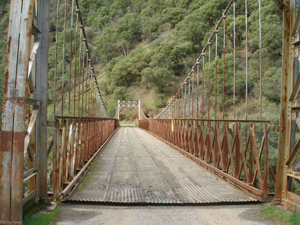 Yankee Jim bridge
Yankee Jim bridge
Volcano is the site of the first public library in California (since it was a rental library, it isn't truly a public library as we know them today). Off the beaten path, Volcano is a real treasure, a tiny place with some really old buildings, including a couple of historic B&Bs. The few residents smiled, said good morning, and enjoyed the mild weather.
After a lovely visit with nephew David, Linda and Seth, we spent the night in Sonora,
which is a staging area for travel to Yosemite National Park. On this Presidents' Day
weekend, the park must be completely full, at least to judge by the number of motorcycles
and cars and trucks headed that way!
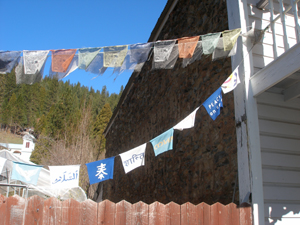 Prayer cloths
Prayer cloths
Route 49 ends in Mariposa, a modern, bustling place scarcely recognizable as a former mining town. Yet this was where the scurrilous John C. Fremont made mining history by his litigation to save his mining claims.
Whatever your pleasure in the mountains, you can satisfy it somewhere along California's storied Gold Rush Trail. Just allow plenty of time to explore the nooks and crannies. If you can, then go off-season to avoid the crowds. And read up on E Clampus Vitus before you start off!